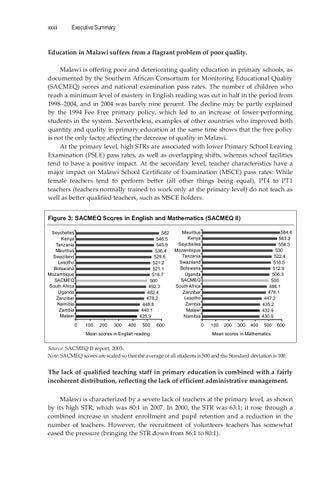xxxii
Executive Summary
Education in Malawi suffers from a flagrant problem of poor quality. Malawi is offering poor and deteriorating quality education in primary schools, as documented by the Southern African Consortium for Monitoring Educational Quality (SACMEQ) scores and national examination pass rates. The number of children who reach a minimum level of mastery in English reading was cut in half in the period from 1998–2004, and in 2004 was barely nine percent. The decline may be partly explained by the 1994 Fee Free primary policy, which led to an increase of lower performing students in the system. Nevertheless, examples of other countries who improved both quantity and quality in primary education at the same time shows that the free policy is not the only factor affecting the decrease of quality in Malawi. At the primary level, high STRs are associated with lower Primary School Leaving Examination (PSLE) pass rates, as well as overlapping shifts, whereas school facilities tend to have a positive impact. At the secondary level, teacher characteristics have a major impact on Malawi School Certificate of Examination (MSCE) pass rates: While female teachers tend to perform better (all other things being equal), PT4 to PT1 teachers (teachers normally trained to work only at the primary level) do not teach as well as better qualified teachers, such as MSCE holders. Figure 3: SACMEQ Scores in English and Mathematics (SACMEQ II) Seychelles Kenya Tanzania Mauritius Swaziland Lesotho Botswana Mozambique SACMEQ South Africa Uganda Zanzibar Namibia Zambia Malawi
582 546.5 545.9 536.4 529.6 521.2 521.1 516.7 500 492.3 482.4 478.2 448.8 440.1 428.9 0
100
200
300
400
500
Mean scores in English reading
600
Mauritius Kenya Seychelles Mozambique Tanzania Swaziland Botswana Uganda SACMEQ South Africa Zanzibar Lesotho Zambia Malawi Namibia
584.6 563.3 554.3 530 522.4 516.5 512.9 506.3 500 486.1 478.1 447.2 435.2 432.9 430.9 0
100
200
300
400
500
600
Mean scores in Mathematics
Source: SACMEQ II report, 2005. Note: SACMEQ scores are scaled so that the average of all students is 500 and the Standard deviation is 100.
The lack of qualified teaching staff in primary education is combined with a fairly incoherent distribution, reflecting the lack of efficient administrative management.
Malawi is characterized by a severe lack of teachers at the primary level, as shown by its high STR, which was 80:1 in 2007. In 2000, the STR was 63:1; it rose through a combined increase in student enrollment and pupil retention and a reduction in the number of teachers. However, the recruitment of volunteers teachers has somewhat eased the pressure (bringing the STR down from 86:1 to 80:1).
